Abstract
The current testing for paralytic shellfish poisoning (PSP) in shellfish is based on the mouse bioassay (MBA). To alleviate animal welfare concerns, we evaluated the utility of using sublethal indicators of toxicity as an alternative to measuring time to death. Live mice were injected with a PSP congener and the changes in neurotransmitter levels were measured 60, 90, and 120 min after injection. Acetylcholine (ACh) was the most sensitive marker for PSP toxicity. The changes in neurotransmitter levels were most pronounced in the blood. Thus, measurement of Ach levels in the blood may serve as a sensitive predictor for PSP that would not require sacrifice of the mice. This method was relatively simple, sensitive (less than 1 μg/kg weight, equivalent to 20 ng/mL), low maintenance, and rapid (less than 60 min).
Similar content being viewed by others
References
AOAC. 1999. Official Method 959.08-paralytic shellfish poison, biological method, 17th ed. Official Methods of Analysis, Vol. 1. Association of official Analytical Chemists, Arlington, VA, USA.
Campas M, Prieto-Simon B, Marty J L. 2007. Biosensors to detect marine toxins: assessing seafood safety. Talanta, 72: 884–895.
Cheng J, Yuan T, Yang L et al. 2005. Neurobiological disruptions induced in brains of the rats fed with mercury contaminated rice collected from experimental fields in Guizhou Province, China. Chin ese Sci ence Bull etin, 50: 2 441–2 447.
Cheng J, Wang W, Jia J, Zheng M, Shi W, Lin X. 2006. Expression of c-fos in rat brain as a prelude marker of central nervous system injury in response to methylmerucyr-stumulation. Biomedical and Environmental Sciences, 19: 67–72.
Cheng J, Song Y, Zhang J, Wu C, Liu Y, Chen X. 2008. Filtration of prelude marker of toxicity of paralytic shellfish poisoning. Journal of Shanghai Jiao Tong University, 42(5): 697–700. (in Chinese with English abstract).
Cheng J, Gu J, Ma J, Chen Xue, Zhang M, Wang W. 2009a. Neurobehavioural effects, redox responses and tissue distribution in rat offspring developmental exposure to BDE-99. Chemosphere, 75: 963–968.
Cheng J, Yang Y, Ma J, Wang W, Liu X, Sakamoto M, Qu Y, Shi W. 2009b. Assessing noxious effects of dietary exposure to methylmercury, PCBs and Se coexisting in environmentally contaminated rice in male mice. Environ. Int., 35: 619–625.
Chou H N, Huang C P, Chen C Y. 2005. Accumulation and depuration of paralytic shellfish poisoning toxins by laboratory cultured purple clam Hiatula diphos Linnaeus. Toxicon, 46: 587–590.
Cianca R C C, Pallares M A, Barbosa R D, Adan L V, Martins J M L, Gago-Martinez A. 2007. Application of precolumn oxidation HPLC method with fluorescence detection to evaluate saxitoxin levels in discrete brain regions of rats. Toxicon, 49: 89–99.
Cook A C, Morris S, Reese R A, Irving S N. 2006. Assessment of fitness for purpose of an insect bioassay using the desert locust (Schistocerca gregaria L.) for the detection of paralytic shellfish toxins in shellfish flesh. Toxicon, 48: 662–671.
Durou C, Poirier L, Amiard J, Budzinski H, Gnassia-Barelli M, Lemenach K, Peluhet L, Mouneyrac C, Roméo M, Amiard-Triquet C. 2007. Biomonitoring in a clean and a multi-contaminated estuary based on biomarkers and chemical analyses in the endobenthic worm Nereis diversicolor. Environmental Pollution, 148: 445–458.
Fairey E R, Shuart N G, Busman M, Moeller P D, Ramsdell J S. 2001. Biomonitoring brevetoxin exposure in mammals using blood collection cards. Environmental Health Perspectives, 109: 717–720.
Fossi M C, Borsani J F, Di Mento R, Marsili L, Casini S, Neri G, Mori G, Ancora S, Leonzio C, Minutoli R, Notarbartolo di Sciara G. 2002. Multi-trial biomarker approach in Meganyctiphanes norvegica: a potential early indicator of health status of the Mediterranean “whale sanctuary”. Marine Environmental Research, 54: 761–767.
Holtrop G, Petrie J, McElhiney J, Dennison N. 2006. Can general anaesthesia be used for the paralytic shellfish poison bioassay? Toxicon, 47: 336–347.
Katsuo D, Kim D, Yamaguchi K, Matsuyama Y, Oda T. 2007. A new simple screening method for the detection of cytotoxic substances produced by harmful red tide phytoplankton. Harmful Algae, 6: 790–798.
Laycock M V, Jellett J F, Easy D J, Donovan M A. 2006. First report of a new rapid assay for diarrhetic shellfish poisoning toxins. Harmful Algae, 5: 74–78.
Lehane L. 2000. Paralytic Shellfish Poisoning: A Review. National Office of Animal and Plant Health Agriculture, Fisheries and Forestry, Canberra, Australia.
Louzao M C, Vieytes M R, Baptista de Sousa, J M V, Leira F, Botana L M. 2001. A fluorimetric method based on changes in membrane potential for screening paralytic shellfish toxins in mussels. Analytical Biochemistry, 289: 246–250.
Schiedek D, Broeg K, Baršienė J, Lehtonen K K, Gercken J, Pfeifer S, Vuontisjärvi H, Vuorinen P J, Dedonyte V, Koehler A, Balk L, Schneider R. 2006. Biomarker responses as indication of contaminant effects in blue mussel (Mytilus edulis) and female eelpout (Zoarces viviparus) from the southwestern Baltic Sea. Marine Pollution Bulletin, 53: 387–405.
Usup G, Leaw C P, Cheah M Y, Ahmad A, Ng B K. 2004. Analysis of paralytic shellfish poisoning toxin congeners by a sodium channel receptor binding assay. Toxicon, 44: 37–43.
Woofter R T, Brendtro K, Ramsdell J S. 2005. Uptake and elimination of brevetoxin in blood of striped mullet (Mugil cephalus) after aqueous exposure to Karenia brevis. Environmental Health Perspectives, 113: 11–16.
Author information
Authors and Affiliations
Corresponding author
Additional information
Supported by the National High Technology Research and Development Program of China (863 Program) (No. 2007AA092001-15), the Key Laboratory of Marine Integrated Monitoring and Applied Technologies of Harmful Algal Blooms, Chinese State Oceanic Administration (No. MATHAB20120101), and the Shanghai Municipal Oceanic Bureau (Nos. 2011-02, 2012-02)
Rights and permissions
About this article
Cite this article
Cheng, J., Pi, S., Ye, S. et al. A new simple screening method for the detection of paralytic shellfish poisoning toxins. Chin. J. Ocean. Limnol. 30, 786–790 (2012). https://doi.org/10.1007/s00343-012-1097-8
Received:
Accepted:
Published:
Issue Date:
DOI: https://doi.org/10.1007/s00343-012-1097-8




